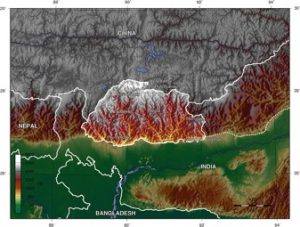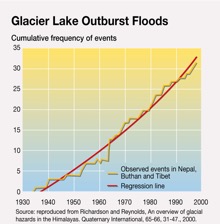When you think of global climate change, what is the first thought that comes to mind? Species extinction? Rising ocean levels? Extreme weather events?
It turns out that all of these are possible, unfortunately! However, one that is often overlooked is the formation of supra-glacial lakes. As temperatures rise, the rate of ice melt has accelerated and has increased the amount of water in glacial lakes. Once triggered by an earthquake or ice fall, the lake will overflow. To make matters worse, the melting of ice-core dams can also destabilize the lakes, forming Glacial Lake Outburst Floods (GLOFs). This means that all communities downstream of glacial lakes are at risk of flooding! An example of this is Bhutan – a landlocked country in South Asia.

A map showing the topography of Bhutan and surrounding countries.
Image Credit: Wikimedia Commons
As you can see, Bhutan consists of rugged land with steep mountains. Most of Bhutan’s population resides in large river valleys, making their lifestyles vulnerable to flooding. Bhutan’s society is not prepared to deal with flooding, since they rely upon their agricultural sector and hydropower as a source of employment and revenue.

A graph showing the recent trend in GLOF in Nepal, Bhutan and Tibet.
Image Credit: Flickr, User GRID Arendal; published under the Creative Commons License.
To lower the risk of flooding, Bhutan’s first project is in the most dangerous glacial lake: Thorthormi Lake. The goal is to create a channel to drain water out of the lake, which is accomplished by releasing pressure on the dam and using tools to dig ice and remove boulders. So far, the lake has been artificially lowered slightly, increasing the safety for downstream communities. The importance of this project and the necessity for further glacial satellite observation is addressed in the video below.
A video about Bhutan’s melting ice, in the perspective of a world exploration challenge.
Video Credit: Vimeo, User Skyship Films, published under the Creative Commons License.
Bhutan is only one example of a community that is directly threatened by climate change. Therefore, we must invest more thought and research into climate change induced disasters, since preparation is key and can offset future damage.
Lexynn Kwan
